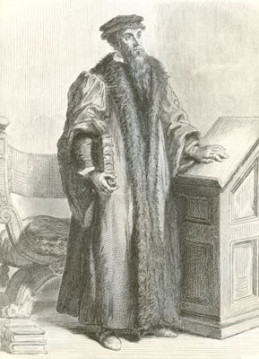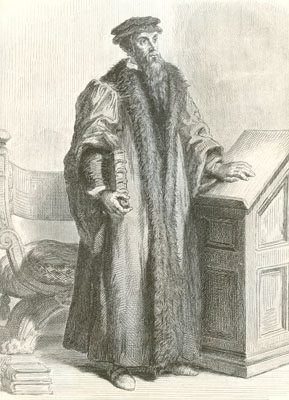
Protestant Reformer John Calvin, an inspiration and guide to many evangelicals. Religion News Service file photo.
American evangelicalism is fractured, probably irreparably. The split between two major camps, which we might roughly label conservatives and progressives, is comprehensive. It was hugely visible in the Larycia Hawkins case at Wheaton. It is visible all the time, if you know where to look.
READ: “Why this resolution of Hawkins case is bad news for American evangelicalism”
This is a very sad development. It goes against the Christian theological confession that the Church is “one, holy, catholic, and apostolic.” It also goes against repeated New Testament exhortations to unity (John 17:11, Col. 3:15). Those exhortations have motivated numerous efforts to bridge the gaps, and on some occasions the tribes do get together for shared goals. But at this point the overall division seems irreparable.
Let me see if I can offer a description of each side that both could acknowledge as generally accurate.
Conservative American evangelicals are a majority of American evangelicals, a very strong majority among white evangelicals in particular.
Conservative evangelicals tend to be conservative across the board.
Theologically, they are strictly conservative and focused on doctrinal clarity and purity. The ascendancy of Calvinist theology has played a major role recently, with leaders as John Piper and R. Albert Mohler, Jr., setting the tone.
Morally, they remain unbending on traditional Christian understandings of moral values, with special focus on bioethical and sexual ethics issues. Look at Franklin Graham as a key example here. He is the latest successor to (the late) Jerry Falwell and (the still active) James Dobson on this front.
Politically, they are conservative and lean strongly Republican. White evangelicals vote for Republican presidential candidates at a 75-80% rate.
Overall, conservative evangelicals tend to be led by white male pastors, activists, and theologians, though there are a number of black, Latino, and Asian-American conservative evangelical leaders as well.
(A huge complexity related to evangelicals of color is that they are conservative theologically but often politically moderate, liberal, or hard to categorize, due to very different social locations and historical experiences than white evangelicals. This is often overlooked. It also creates tensions when multi-racial groups of evangelicals try to work and worship together.)
Progressive evangelicals are still conservative by many religiosity measures (Christ-centered, conversionist, evangelistic, Bible-focused). They tend to center on the moral practice of Jesus and are less focused on guarding doctrinal boundaries. Evangelicals who identify with the Radical Reformation and Pietist traditions are more likely to move to this side of the fence.
Morally, though usually traditional in their own practices, they tend toward a greater emphasis on compassion and eschewing negative judgments of others. Some (not all) have moved to a place of inclusion of gay people and support for their covenantal/marital relationships, at least at a civil level. They tend toward economic equality and environmental commitments and to oppose war and the death penalty.
Politically, they lean independent or Democrat. They tend to speak the language of social justice. Progressive evangelicals are disproportionately younger and less white. Leaders include Jim Wallis, Rachel Held Evans, Lisa Sharon Harper, Soong-Chan Rah, and Brian McLaren.
Conservative evangelicals are angry about abortion and gay marriage. Progressive evangelicals are angry about racism, sexism, and Islamophobia.
Conservatives tend to accept a narrative of cultural decline. Progressives tend to reject that narrative due to a focus on historic American racism and other sins.
Conservatives are concerned about protecting religious liberty. Progressives are more concerned about protecting LGBT people from discrimination.
Conservatives tend to be strongly pro-Israel. Progressives aim for balance or side with the Palestinian cause.
I could name a hundred other fractures.
In a 2008 book I argued for a category called “centrist evangelicals.” I said that they occupied as much as 30% of evangelicalism in the US. But in the meantime, polarization has nearly evacuated that category of any serious and visible leaders or institutions. The center is collapsing, and this 30% is moving right or left or right out of evangelicalism altogether.
One last bifurcation: Conservative evangelicals tend to caricature progressive evangelicals as liberal Protestants. Progressives tend to caricature conservatives as fundamentalists.
That takes us back to the very origins of modern American fundamentalism — and liberalism. The so-called “fundamentalist-modernist” controversy emerged in the late 19th and early 20th centuries over issues such as evolution, biblical inspiration, and historical-critical study of the Bible. The fundamentalists wanted to resist the winds of modernity, while the liberals believed Christianity needed to respond to modernity by integrating its insights and claims into the faith. The modernists became identified with mainline Protestantism. The fundamentalists rejected mainline Protestantism and set up their own separate subculture/s.
What we now call American evangelicalism was a descendant of the fundamentalist side of this controversy. But then World War II era leaders like Carl Henry sought to pull fundamentalists out of their enclaves and into full engagement with culture, including academia, media, and politics. For this new effort Henry and others retrieved the term “evangelical.” It was a brilliant move.
Seventy years later, though, the descendants of the Henry-era evangelicals are fractured. One might even consider the radical idea that “evangelicalism” was a fictive rather than real religious community. In any case, the community bearing that name is today slipping back into the divisions (or labels) of a hundred years ago, when we need to be moving forward to face the challenges of the 21st century.
The differences appear irreconcilable. Angst and bitterness often get the better of us as we discover and debate those differences.
Conservative and progressive evangelicals need to let each other go their separate ways, acknowledging that despite shared faith in Christ we have become two separate religious communities. Our fighting is doing no one any good at all.





